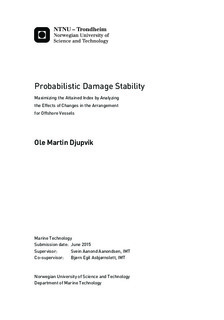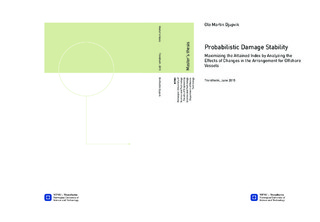| dc.description.abstract | Probabilistic damage stability calculations are time demanding and are conducted at a late stage of the design process. A detailed arrangement is required to calculate whether a ship fulfills the requirements. To minimize the amount of iterations in the design process Naval Architects have to know how the attained index is affected by the watertight arrangement.
The longitudinal wing tank bulkhead in the mid-ship section of a vessel, is a bulkhead that applies for all offshore vessels. The placement of this bulkhead, in regards to maximizing the attained index, has been a subject of discussion in Wärtsilä Ship Design. The objective of this dissertation has been to analyze how the attained index is affected by the transverse position of the longitudinal wing tank bulkhead. This information can be used to maximize the attained index for offshore vessels. To find out if the attained index changes proportionally for different ship sizes, the study determines if there is a correlation between the placement of the bulkhead and the attained index for four different vessel sizes.
To reveal how the attained index develops for different arrangement configurations, the four vessels had two different arrangements. One arrangement had U-tanks, arrangement B, and the other arrangement had two longitudinal bulkheads in the double bottom without U-tanks, arrangement C. Since it is common practice to include U-tanks to maximize the attained index, the report also studies how much the attained index increases when U-tanks are introduced.
The results of the attained index for the four vessels with different placements of the longitudinal wing tank bulkhead, can be seen in the graph below. There is not a correlation of the attained index and the placement of the longitudinal bulkhead, for all vessels with different arrangement configurations. It was therefore not possible to develop a formula for the optimal placement of the bulkhead that applies for all vessel types and sizes. By analyzing the development of the attained index, as the longitudinal bulkhead was relocated, we found out which parameters that affected the attained index.
As seen from the results, the attained index increases as the longitudinal bulkhead is moved towards the centerline for all vessels with U-tank arrangement. The development of the total attained index levels out when U-tank damages are critical for the survivability of the vessel.
For vessels without U-tanks the development of the total attained index did not correspond for all vessels. The attained indexes increases for Vessel II, III and IV until damages to the wing tanks are critical for the survivability of these vessels. The common denominator for all vessels with U-tanks are that the total attained index decreases when damages to the wing tanks are critical for the survivability of the vessels.
The total attained index for the two arrangement with and without U-tanks were compared. It was found that the effect of introducing wing tanks is approximately 7%, when the longitudinal wing tank bulkhead is placed at B/20. The effect of introducing U-tanks increases as the distance between the hull and the longitudinal wing tank bulkhead increases.
Is it possible to maximize the attained index by evaluating the placement of the longitudinal bulkhead? The effect of changing the position of the bulkhead changes according to the arrangement configuration. As different vessel types have different arrangement configurations it is difficult to predict the effect of relocating the longitudinal bulkhead. The flowchart below can be used by designers as a tool to help them maximize the attained index when placing the longitudinal wing tank bulkhead. | |

